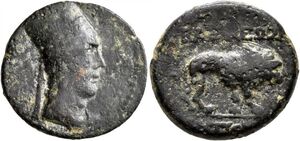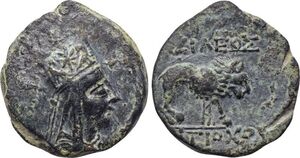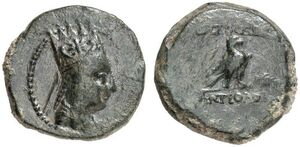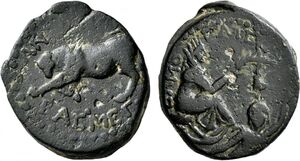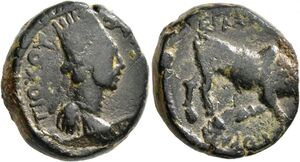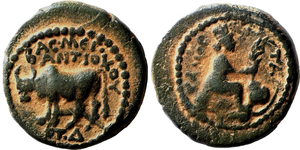Antiochus I c.70-36 BC (Kov 225-229)
Description
Antiochus Theos Dikaios Epiphanes Philoromaios Philhellenos (BNP [16]) was the son of Mithradates I and Laodice Thea Philadelphus, daughter of Antiochus VIII and Cleopatra Tryphaina.
Antiochus managed to maintain his kingdom throughout a turbulent period despite the conflict between Rome and Parthia, the third Mithradatic War (73-63 BC), and the disintegration of the Seleucid Empire. Lucullus left his kingdom intact, and Pompey later extended it to the Euphrates. In return, Antiochus supported Pompey in the Civil War, but Caesar's victory left Antiochus seeking an alliance with Parthia. In 38 BC Antiochus was besieged in his capital, Samosata by Ventidius, and again by Antony, but withstood both assaults, and finally made peace with Rome. It was likely during this siege that he associated his son Mithridates with him as co-regent. Antiochus died soon after, around 36 BC (BNP 1, 766).
The coins of this reign depict Antiochus wearing two distinctly different crowns. The earlier crown has a slightly rounded top and is reminiscent of the Second Series crown of Arsames (Sophene, nos. 4-10); it likely indicates a higher status than the satrapal bashlyk. The second crown is identical to the Armenian tiara of Tigranes the Great and was almost certainly adopted after the latter's death. The wearing of the star and eagles tiara may have been a bone of contention with Artavasdes II, who wore the same crown as inherited from his father.
The first and second series of bronze coins are distinguished only by the crown. The reverse types, lion and eagle, are the same for both first and second series coins. The third (last) series, proclaiming the co-regency with his son, Mithradates, consists of a single denomination (8 chalkoi) which features a zebu on the reverse rather than the expected portrait of Mithradates.
Kovacs, Frank L. “Armenian Coinage in the Classical Period” CNS 10, Classical Numismatic Group, Lancaster, 2016, pp. 40.
Antiochus managed to maintain his kingdom throughout a turbulent period despite the conflict between Rome and Parthia, the third Mithradatic War (73-63 BC), and the disintegration of the Seleucid Empire. Lucullus left his kingdom intact, and Pompey later extended it to the Euphrates. In return, Antiochus supported Pompey in the Civil War, but Caesar's victory left Antiochus seeking an alliance with Parthia. In 38 BC Antiochus was besieged in his capital, Samosata by Ventidius, and again by Antony, but withstood both assaults, and finally made peace with Rome. It was likely during this siege that he associated his son Mithridates with him as co-regent. Antiochus died soon after, around 36 BC (BNP 1, 766).
The coins of this reign depict Antiochus wearing two distinctly different crowns. The earlier crown has a slightly rounded top and is reminiscent of the Second Series crown of Arsames (Sophene, nos. 4-10); it likely indicates a higher status than the satrapal bashlyk. The second crown is identical to the Armenian tiara of Tigranes the Great and was almost certainly adopted after the latter's death. The wearing of the star and eagles tiara may have been a bone of contention with Artavasdes II, who wore the same crown as inherited from his father.
The first and second series of bronze coins are distinguished only by the crown. The reverse types, lion and eagle, are the same for both first and second series coins. The third (last) series, proclaiming the co-regency with his son, Mithradates, consists of a single denomination (8 chalkoi) which features a zebu on the reverse rather than the expected portrait of Mithradates.
Kovacs, Frank L. “Armenian Coinage in the Classical Period” CNS 10, Classical Numismatic Group, Lancaster, 2016, pp. 40.

